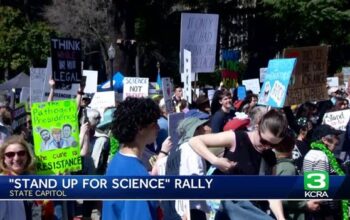How many homeless could be helped with $87 million? How many affordable and low cost housing could be created with $87 million? Think crime fighting or firefighting could use $87 million? Yet, Sacramento Democrats have decided to help spend $87 million to build a bridge from one side of the 101 freeway to the other so animals can cross the bridge. No, this is not a chicken joke where you ask why did the chicken cross the road? This is real—Sacramento Democrats actually believe animals are literate and can read a sign that says, “Bridge crossing here”. We can’t teach third graders to red, but government will get a mountain lion to read Shakespeare.
“Caltrans expects to break ground early next year for an $87-million wildlife crossing on the 101 Freeway in Agoura Hills that experts say is critical to help save an isolated population of mountain lions in the region from extinction.
The bridge at Liberty Canyon, which has been a dream of conservationists for years, will allow mountain lions and other species to cross safely over a busy eight-lane stretch of the freeway used by an estimated 300,000 vehicles a day, officials said.
Note they know how many cars go past this section of freeway each day—not a word about the number of animals that would cross the bridge? 12, 50 or 1,000’s? This is an example of the craziness of California—animals before people.
Caltrans projected to break ground on wildlife bridge over 101 Freeway in January 2022
By Laura Anaya-Morga, LA Times, 10/9/21

Caltrans expects to break ground early next year for an $87-million wildlife crossing on the 101 Freeway in Agoura Hills that experts say is critical to help save an isolated population of mountain lions in the region from extinction.
The bridge at Liberty Canyon, which has been a dream of conservationists for years, will allow mountain lions and other species to cross safely over a busy eight-lane stretch of the freeway used by an estimated 300,000 vehicles a day, officials said.
When completed, the 200-foot-long, 165-foot-wide wildlife bridge will be the largest of its kind in the world, officials said. The project is being backed by a number of public and private organizations including the California Department of Transportation and the National Wildlife Federation, officials said.
The project will likely go out to bid next month with construction set to begin in late January, said Sheik Moinuddin, a Caltrans project manager. The project will be divided into two phases, the first will cover the area across the 101 Freeway and the second will cover the two-lane stretch across Agoura Road.
Officials noted that it has taken years to raise awareness and the money to make the project a reality.
“This is an unprecedented project that Los Angeles should be incredibly proud of,” said Beth Pratt, regional executive director in California for the National Wildlife Federation who has been working on the project for almost a decade. “Back then it was just an idea.”
The nonprofit federation has managed to raise more than $72 million so far from more than 4,000 private, philanthropic and corporate donors around the world for their #SaveLACougars campaign. Those funds include a $25-million challenge grant from Wallis Annenberg and the Annenberg Foundation. The federation hopes to raise $6 million more by the end of the year to cover construction costs.
The bridge, which was recently renamed the Wallis Annenberg Wildlife Crossing, is set to be completed by October 2023, officials said. As envisioned, the bridge will be designed to look like part of the natural landscape with native vegetation and irrigation systems. It will shield animals from the commotion below with sound walls and light deflectors to dampen the effects of the noise and glare of headlights.
The project will set a worldwide model for what is possible in terms of coexistence in urban places between wildlife and humans, Pratt said. The purpose of the bridge is to reverse the effects that fragmented landscapes have had on wildlife, including low genetic diversity and roadkill.
Upon the opening of the bridge, Pratt said she is most excited to see photos of the first animals using it.
“That’s when we’ll know we’ve made the Santa Monica Mountains whole again,” she said.



